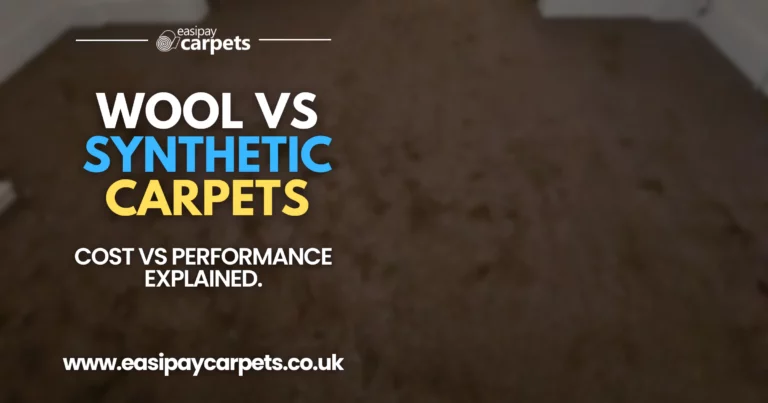

Wool vs Synthetic Carpets – Which Is Best?
When choosing a new carpet, one of the biggest decisions is wool vs synthetic. Both have their advantages, but the right choice depends on factors like durability, budget, maintenance, and lifestyle needs.
This guide will compare wool and synthetic carpets, highlighting their strengths, weaknesses, and the best rooms for each type.
What’s the Difference Between Wool and Synthetic Carpets?
Wool Carpets
Wool is a natural fibre, sourced mainly from sheep. It has been used in carpets for centuries and is known for its luxury, durability, and warmth.
Synthetic Carpets
Synthetic carpets are made from man-made fibres, such as:
- Polypropylene – Budget-friendly, stain-resistant, and water-resistant.
- Nylon – Durable, soft, and resilient to wear.
- Polyester – Soft and stain-resistant but less durable than nylon.
- Acrylic – Mimics wool but isn’t as long-lasting.
Comparing Wool & Synthetic Carpets
| Feature | Wool Carpet | Synthetic Carpet |
|---|---|---|
| Durability | Very durable, lasts up to 20+ years | Good durability, but lifespan depends on fibre type |
| Softness | Naturally soft underfoot | Varies—nylon and polyester feel softer than polypropylene |
| Stain Resistance | Naturally stain-resistant but can absorb liquid | Highly stain-resistant, especially polypropylene |
| Moisture Resistance | Absorbs moisture, can develop mould if not dried | Water-resistant, ideal for damp areas |
| Cleaning & Maintenance | Requires professional cleaning occasionally | Easy to clean with standard carpet cleaners |
| Eco-Friendliness | 100% natural, biodegradable, sustainable | Made from plastics, not biodegradable |
| Allergy-Friendly | Traps allergens, but may not be ideal for allergy sufferers | Some synthetic options are hypoallergenic |
| Cost | More expensive | Budget-friendly options available |
| Flammability | Naturally flame-retardant | Can melt or burn if exposed to flames |
| Best For | Bedrooms, living rooms, areas needing warmth | High-traffic areas, rental homes, spill-prone areas |
Advantages of Wool Carpets
✅ Natural & Sustainable – Wool is biodegradable and renewable, making it an eco-friendly choice.
✅ Warm & Insulating – Wool provides excellent insulation, helping to retain warmth in winter and regulate temperature in summer.
✅ Durable & Long-Lasting – High-quality wool carpets can last 20+ years with proper care.
✅ Naturally Stain-Resistant – Wool has a protective outer layer that repels dirt and stains.
✅ Soft & Luxurious Feel – Wool carpets feel plush and comfortable underfoot.
✅ Flame-Resistant – Wool is naturally flame-retardant, making it a safer option.
Disadvantages of Wool Carpets
❌ Expensive – Wool carpets are generally more costly than synthetic options.
❌ Absorbs Moisture – Wool can hold onto moisture, leading to potential mould issues in humid areas.
❌ Requires Professional Cleaning – Wool needs specialised cleaning to maintain its quality.
❌ Can Fade in Sunlight – Direct sunlight can cause colour fading over time.
Advantages of Synthetic Carpets
✅ Budget-Friendly – Synthetic carpets are more affordable, making them ideal for large areas or rental properties.
✅ Highly Stain-Resistant – Polypropylene and polyester carpets are extremely resistant to stains, making them ideal for homes with kids and pets.
✅ Water-Resistant – Synthetic fibres don’t absorb moisture, meaning they won’t develop mould or mildew.
✅ Easy to Clean – Synthetic carpets are low-maintenance and can be cleaned with regular carpet shampoos.
✅ Variety of Styles & Colours – Available in a wide range of colours, textures, and patterns.
Disadvantages of Synthetic Carpets
❌ Not as Durable as Wool – While nylon is long-lasting, other synthetic fibres may flatten faster under heavy foot traffic.
❌ Can Feel Less Soft Over Time – Some synthetic fibres may lose their softness after years of use.
❌ Not as Eco-Friendly – Synthetic carpets are made from plastic-based materials and are not biodegradable.
❌ Can Be Flammable – Synthetic carpets can melt or burn if exposed to flames.
Best Rooms for Wool & Synthetic Carpets
Best Rooms for Wool Carpets:
✔ Bedrooms – Soft, warm, and luxurious underfoot.
✔ Living Rooms – Adds warmth and a high-end feel.
✔ Staircases & Hallways – High durability makes it suitable for high-traffic areas.
Best Rooms for Synthetic Carpets:
✔ Children’s Rooms & Playrooms – Stain-resistant and easy to clean.
✔ Rental Properties – Budget-friendly and durable for frequent tenant turnover.
✔ Dining Rooms – Handles spills and stains better than wool.
✔ Basements – Water-resistant synthetic carpets prevent moisture damage.
Which Carpet is Best for You?
Choose Wool If:
- You want a luxurious, soft feel underfoot.
- You’re looking for a natural and eco-friendly flooring option.
- You need a long-lasting, high-quality carpet.
- You’re okay with investing in higher upfront costs for durability.
Choose Synthetic If:
- You need a budget-friendly carpet option.
- You want stain and moisture resistance (ideal for kids & pets).
- You prefer a carpet that’s easy to maintain.
- You’re installing carpet in a high-traffic or rental property.
Conclusion
Both wool and synthetic carpets have their advantages and disadvantages, so the best choice depends on your budget, lifestyle, and room usage.
- For luxury, warmth, and durability, wool is the best choice.
- For affordability, stain resistance, and easy maintenance, synthetic carpets are the better option.
By considering where the carpet will be used and what’s most important to you, you can confidently choose the best flooring for your home.
Are you on the hunt for new flooring? With Easipay Carpets you can get the flooring of your dreams from as little as £10 per week, completely interest free! We offer Carpets, Vinyl and Laminate flooring with free underlay, door bars, carpet grippers and beading wherever needed on payment plans that spread the cost of the flooring into smaller, more manageable payments. Find out more at the button below!
Still Got Questions? Here's 10 FAQs!
Yes, wool carpets are long-lasting, eco-friendly, and luxurious, making them a great long-term investment.
Nylon carpets are the most durable synthetic option, resisting wear and flattening.
Wool is naturally stain-resistant, but spills should be cleaned quickly to prevent absorption.
Yes, synthetic carpets like nylon are ideal for high-traffic spaces like hallways and staircases.
Some high-quality synthetics (like soft nylon or polyester) can feel very soft, but wool remains the superior option for natural softness.
Wool carpets trap dust and allergens, which can be good or bad depending on how frequently you clean. Some synthetic carpets are hypoallergenic.
Yes, wool carpets benefit from professional cleaning every 12-18 months to maintain their quality.
Yes, wool is naturally flame-retardant, whereas synthetic carpets can melt under high heat.
Wool is biodegradable and renewable, making it the better eco-friendly choice.
Yes, synthetic carpets are water-resistant and a better choice for basements or humid areas.




